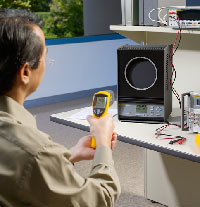How does emissivity make a temperature difference?
 Emissivity makes a temperature difference for infrared thermometers. Frank Liebman, an engineer with Fluke Calibration, demonstrates the impact that surface emissivity has on temperature measurement and temperature calibration using a modified Fluke blackbody calibrator and Fluke Thermal Imager.Product Information »
Emissivity makes a temperature difference for infrared thermometers. Frank Liebman, an engineer with Fluke Calibration, demonstrates the impact that surface emissivity has on temperature measurement and temperature calibration using a modified Fluke blackbody calibrator and Fluke Thermal Imager.Product Information »
Transcript:
Hi, my name is Frank Liebman. I’m a senior design engineer for Fluke and I was one of the principal engineers on the precision IR calibrator that you can see right here.
If you have an IR thermometer, you would think that the reading is accurate. But if you have two IR thermometers and they have different readings, what is the solution?
Well, the solution is calibration. What happens when it gets different temperature readings on the same surface? Let’s take a look at an example of this with the Fluke Thermal Imager.
You can see one side is aluminum, it’s bare metal and the other side is painted metal. The painted metal actually has higher emissivity, this is why the aluminum is colder even though it isn’t. The fact that the painted surface can vary by up to 2% emissivity. On 500 °C, this means that you can have a 7°C temperature difference on your IR thermometer.
Now what does this mean in terms of calibration? What it means is that we need to know the emissivity and be able to match the surface emissivity for an IR thermometer. This is kind of hard to do though because surfaces generally don’t have a fixed emissivity. The solution is to do a radio metric calibration on your surface, this is what we do with the Fluke Precision Infrared Calibrator.
Keep learning
Infrared Thermometer Calibration -- A Complete Guide
Infrared Temperature Calibration 101
Resource Center for Precision Infrared Calibrators
Related products
4180, 4181 Precision Infrared Calibrators
9132 and 9133 Portable Infrared Calibrators
Get Help
Speak with a calibration product expert about your equipment needs

